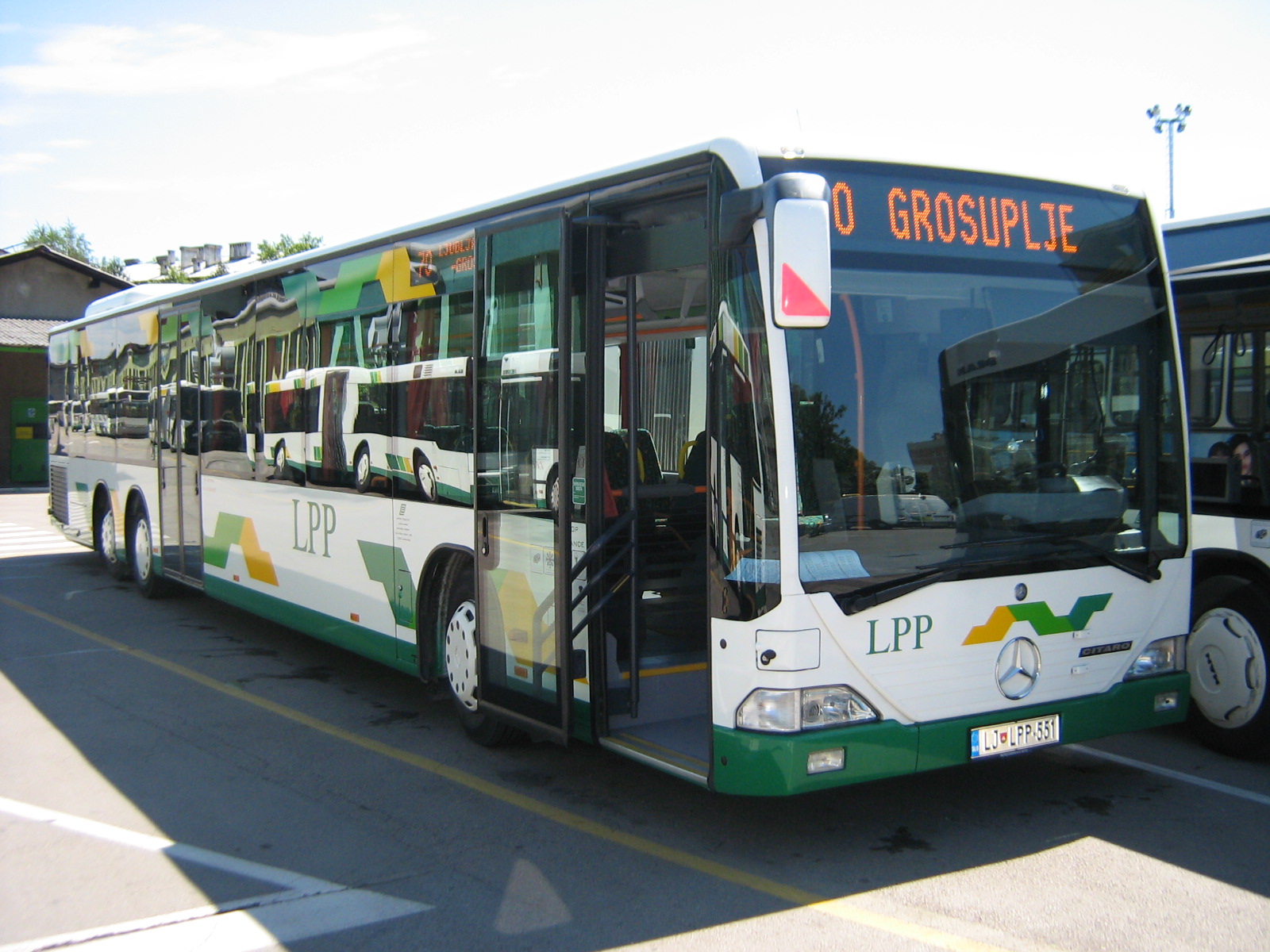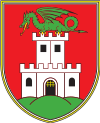Transport
Air
Ljubljana Jože Pučnik Airport (IATA code LJU),
located 26 kilometers (16 mi) northwest of the city, has flights to
numerous European destinations. Among the companies that fly from there
are Adria Airways, Air France, easyJet, Finnair, Job Air, Montenegro Airlines, Wizz Air and Turkish
Airlines. The destinations are mainly European. This
airport has superseded the original Ljubljana airport, in
operation from 1933 until 1963. It was located in the Municipality
of Polje (nowadays the Moste
District), on a plain between Ljubljanica and Sava next to the railroad in
Moste. There
was a military airport in Šiška from 1918 until 1929.
Rail
In the Ljubljana Rail Hub,
the Pan-European railway corridors V (the fastest
link between the North Adriatic, and Central and Eastern Europe) and X (linking Central Europe with the Balkans) and
the main European lines (E 65, E 69, E 70)
intersect. All
international transit trains in Slovenia drive through the Ljubljana hub, and
all international passenger trains stop there. The area of Ljubljana has six
passenger stations and nine stops. For passengers,
the Slovenian Railways company offers the
possibility to buy a daily or monthly city pass that can be used to travel
between them. The Ljubljana railway station is the
central station of the hub. The Ljubljana Moste
Railway Station is the largest Slovenian railway dispatching place.
The Ljubljana Zalog
Railway Station is the central Slovenian rail yard. There
are a number of industrial rails in Ljubljana. At the end
of 2006 the Ljubljana Castle funicular started
to operate. The rail goes from Krek Square (Krekov trg)
near the Ljubljana Central Market to Ljubljana
Castle. It is especially popular among tourists. The full trip lasts
60 s.
 |
| Central railway station once. |
 |
| Ljubljana railway station today. Photo: Viktorija Rozman |
Roads
Ljubljana is located where Slovenia's two main freeways
intersect, connecting the freeway route from east to west, in line with Pan-European Corridor V,
and the freeway in the north–south direction, in line with Pan-European Corridor X. The city is linked
to the southwest by A1-E70 to the Italian cities of Trieste and Venice and the
Croatian port of Rijeka.[172] To
the north, A1-E57 leads to Maribor, Graz and Vienna. To the
east, A2-E70links it with the Croatian capital Zagreb, from where
one can go to Hungary or important cities of the former Yugoslavia,
such as Belgrade.
To the northwest, A2-E61 goes to the Austrian towns of Klagenfurt and Salzburg,
making it an important entry point for northern
European tourists. A toll sticker system has been in use on theLjubljana Ring Road since 1 July 2008. The
center of the city is more difficult to access especially in the peak hours due
to long arteries with traffic lights and a large number of daily commuters. The
strict city center has been closed for motor traffic since September 2007,
except for residents with permissions.
Public motorized road transport in Ljubljana was originally
a tram system completed in 1901. It was in use
from September 1901 until July 1928, when it was replaced with buses. Due to
the financial loss of the bus traffic, the buses were abolished in 1930 and
replaced with trams in 1931. In reached its final form with the length of 18.5
kilometers (11.5 mi) in 1940. In the post World War II era, the tram
system was taken out of service, as it took up a lot of space in an era when
automobiles were becoming increasingly more important. In Ljubljana, the tram's
end came in December 1958. Soon after the last day of operation, the tracks
were dismantled and the cars were transferred to Osijek and Subotica. Reintroduction
of an actual tram system to Ljubljana has been proposed repeatedly in the
2000s.
| Tram (1901-1958) Tickets |
| It was once the tram in Ljubljana (1901-1958) |
| Traim in Slovenian stret. |
More of pictures you can see on:
City bus
The Ljubljana Bus Station,
the Ljubljana central bus hub, is located next to the Ljubljana railway
station. The city bus network, run by the Ljubljana Passenger Transport (LPP)company, is Ljubljana's most widely used means of public
transport. The fleet is relatively modern. The number of dedicated bus
lines is limited, which can cause problem in peak hours when traffic becomes
congested. Bus rides may be paid with the Urbana payment card (also used for the
funicular) or with a mobile phone. Sometimes the buses are called trole (referring
to trolley
poles), harking back to the 1951–71 days when Ljubljana had trolleybus (trolejbus)
service. There were five trolleybus lines in
Ljubljana, until 1958 alongside the tram. There are numerous taxi companies
in the city, but their services have been evaluated as bad.
Another mean of public road transport in the city center is
the Cavalier (Kavalir), an electric vehicle operated by LPP since May
2009.
There are two such vehicles in Ljubljana. The ride is free and there are no stations because it can be stopped anywhere. It can carry up to five passengers; most of them are elderly people and tourist. The Cavalier drives in the car-free zone in the Ljubljana downtown. The first line links Čop Street, Wolf Street and Hribar Embankment, whereas the second links Town Square, Upper Square, and Old Square. There is also a tractor with wagons decorated to look like a train for tourists in Ljubljana, linking Cyril and Methodius Square in the city center with Ljubljana Castle.
| Kavalir |
There are two such vehicles in Ljubljana. The ride is free and there are no stations because it can be stopped anywhere. It can carry up to five passengers; most of them are elderly people and tourist. The Cavalier drives in the car-free zone in the Ljubljana downtown. The first line links Čop Street, Wolf Street and Hribar Embankment, whereas the second links Town Square, Upper Square, and Old Square. There is also a tractor with wagons decorated to look like a train for tourists in Ljubljana, linking Cyril and Methodius Square in the city center with Ljubljana Castle.
Trolleybus:
More pictures you can see on:
Bicycles
There is a considerable amount of bicycle traffic
in Ljubljana, especially in the warmer months of the year. It is also possible
to rent a bike. Since May 2011, the Bicikelj (Official page), a
self-service bicycle rental system offers the
residents and visitors of Ljubljana 300 bicycles and 600 parking spots at 31
stations in the wider city center area. The daily number of rentals is around
2,500. There was a possibility to rent a bike even before the establishment of
Bicikelj.
However, the conditions for cyclists in Ljubljana have been
criticized as unfortunate to date. This refers to cycle lanes in poor condition
and constructed in a way that motorized traffic is privileged. In contrast to
other European capitals, on some of the main streets cycling is forbidden; for
example, on part of Slovenska cesta (Slovene
Street) and on a new link road on the Fabiani Bridge across
the Ljubljanica River connecting Hrvatski trg and Roška cesta. There are also
many one-way streets which therefore cannot be used as alternate routes so it
is difficult to legally travel by bicycle through the city center. Through
years, some prohibitions have been partially abolished by marking cycle lanes on
the pavement.
Water
The river transport on the Ljubljanica and the Sava was the
main means of cargo transport to and from the city until the mid-19th century,
when railroads were built. Today, the Ljubljanica is used by a number of
tourist ships, with wharves under the Butchers'
Bridge, at Fish Square, at Court Square,
at Breg, at the Poljane Embankment, and
elsewhere.
 |
| Ljubljana market, behind the Cathedral, on the right side Kresija Photo: Viktorija Rozman |



,_Zbirka_upodobitev_znanih_Slovencev_NUK.jpg_-_Crop1.jpg)








